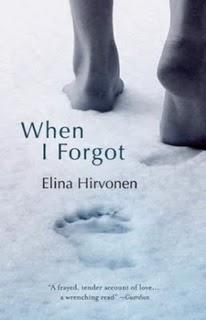When I Forgot

This kind of forgetting does not erase memory, it lays the emotion surrounding the memory to rest. – Clarissa Estes
The protagonist of this short, dense novel is Anna Louhiniitty, a twenty-something Finnish journalist. It’s a slushy April day in Helsinki. Anna sits at a café table. She’s supposed to be transcribing an interview.
On the table sits a copy of Virginia Woolf’s Mrs. Dalloway, that famous novel of war, suicide, and society parties. Anna’s lover, Ian, an expatriate American who teaches modernist literature at the local university, has given her the novel. But just as Anna cannot work, she cannot read the book either. Instead, she thinks of Woolf’s demise. Thus Anna spends the day alone gulping coffee and campari and reliving the events of her childhood and adolescence, her dysfunctional family, and Ian’s dysfunctional family. This remembering forms the substance of the novel’s scenes and trajectory.
Elina Hirvonen, author of When I Forgot, is a Finnish TV host, documentary filmmaker, and producer of current affairs programmes. She is also editor-in-chief of a feminist magazine, Tulva (The Flood). This fiction, her first, has become the most successful debut novel ever in Finland. Hirvonen’s writing style is spare and pithy. Her handling of the fractured narrative—temporal discontinuities, flashbacks within flashbacks, brief letters, imaginings, and other voices telling their stories—is skillful. The consequence of this style is that the reader, like Anna, must work to assemble the pieces from the past in order to understand the present.
That past has its redemptive moments, but is generally not a happy one. Anna’s wan mother is given to hectoring her only daughter. Her father, a minister, has beaten his son, Joona—until Joona grows enough to retaliate. Anna’s grandfather has been ruined by his soldiering in WWII, just as Ian’s father is from participating in the Vietnam holocaust. (Strong anti-war sentiments pervade the novel.) Ian’s mother becomes a basket case until she becomes a Republican (same thing in different guise?). Ian is plagued by 9/11 because he was living in New York when the planes hit the towers. Anna has scars on her wrists. This overlapping of themes and lives gives the novel great resonance. Traumatic experience and suffering, Hirvonen suggests, may seem different in particulars, but is universal in its visitation and effects upon us all.
This brief sketch could make When I Forgot appear to be yet another examination of the depressif realities of northern peoples (the literatures of Canada and Russia, for example, are replete with downbeat narratives). As a child, Anna prays to God; as an adult, she imagines Hollywood endings; both strategies prove fatuous. Yet the spring season, which is the present tense in this novel, hints that all will not be lost in Helsinki.
Anna’s childhood bond with Joona has been crucial; she has also been twisted by it. His mounting insanity drives her to the brink, too. Meeting Ian and falling in love with him helps Anna to break free from Joona and from her parents. Ian is no paradigm of mental health himself; however, the lovers’ connection ultimately directs them from their pasts and allows them to journey together renewed. Does this sound simplistic or romantic? Anna and Ian overcome so much personal detritus that their hard-won victory seems convincing enough. In this way, Anna’s story is an honouring of Mrs. Dalloway and its author—via themes and method—and a rebuff. Take those rocks from your pockets, Virginia. Happiness lives though it’s a tough go to get there.
In sum, when was the last time you read an excellent Finnish novel? Never, right? Well here’s your chance, and well worth the read it is. For this we have Tin House Books to praise. This little publishing concern up in Oregon, like Dalkey Archive in Illinois, is keeping the faith by printing interesting, somewhat experimental fiction that isn’t remotely like Dan Brown's or any other mega-seller like him. Yippee!